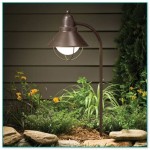Troubleshooting an Outdoor Lighting Transformer Not Working
An outdoor lighting transformer is a crucial component of any outdoor lighting system, as it converts the high voltage of household electricity to a lower voltage that is safe for outdoor lighting fixtures. However, like any electrical device, outdoor lighting transformers can sometimes malfunction, leaving your outdoor lighting system inoperable.
If your outdoor lighting transformer is not working, there are a few essential aspects to consider:
1. Check the Power Source
Before troubleshooting the transformer itself, it's essential to ensure that the power source is functioning. Check if the circuit breaker or fuse connected to the transformer is tripped or blown. If so, reset the breaker or replace the fuse. Additionally, verify that the transformer is properly plugged into the electrical outlet.
2. Examine the Transformer's Connections
Loose or faulty connections can disrupt the flow of electricity through the transformer. Disconnect the transformer from the power source and inspect the wires and terminals for any signs of damage or corrosion. Use a wire brush or sandpaper to clean any dirty or corroded connections and ensure they are securely tightened.
3. Test the Transformer
To determine if the transformer is functioning correctly, use a voltmeter. Set the voltmeter to the AC voltage range and connect the probes to the transformer's output terminals. If the voltmeter reads close to the rated output voltage of the transformer (usually around 12 or 24 volts), the transformer is likely operational.
4. Inspect the Lighting Fixtures
If the transformer passes the voltage test, the issue may lie with the lighting fixtures. Disconnect each fixture from the transformer and check for any blown bulbs or faulty wiring. Replace any defective bulbs and repair any loose or damaged wires.
5. Check for GFCI (Ground Fault Circuit Interrupter) Trips
GFCIs are safety devices designed to prevent electrical shock. If there is a fault in the electrical circuit, the GFCI will trip and cut off the power supply. Check if any GFCIs in the circuit connected to the transformer have tripped. Resetting the GFCI by pressing the reset button may restore power to the transformer.
6. Consider Environmental Factors
Moisture and extreme temperatures can affect the performance of outdoor lighting transformers. Ensure the transformer is installed in a dry and well-ventilated location. Prolonged exposure to moisture or extreme heat can damage the transformer's internal components.
7. Check for Overload
Overloading a transformer can cause it to overheat and malfunction. Calculate the total wattage of the lighting fixtures connected to the transformer and compare it to the transformer's rated capacity. If the total wattage exceeds the transformer's capacity, the transformer may not be able to provide sufficient power to operate all the fixtures.
Conclusion
Troubleshooting an outdoor lighting transformer not working requires a systematic approach. By following these essential aspects, you can identify the cause of the malfunction and restore the functionality of your outdoor lighting system. If you encounter any significant issues or lack the electrical expertise to safely troubleshoot the transformer, it's advisable to consult with a qualified electrician.

Outdoor Landscape Light Troubleshooting Guide Abulous Lighting

Landscape Lights Not Working Solutions To 7 Common Problems

Landscape Lighting Replace A Transformer

Troubleshooting Low Voltage Landscape Transformer Led Systems Lighting Pro

Landscape Lighting Transformer Repair How To Add A Dusk Dawn Sensor

Low Voltage Outdoor Landscape Lighting Transformer What To Do When All Your Lights Stop Working

How Professional Transformers Compare To The Competition Luminocity

Low Voltage Landscape Lighting Transformer Integrated Photocell And Timer Diode Drive Power Supplies

Malibu Low Voltage Transformer Installation Troubleshooting 2024

Portfolio 12 Volt Multi Tap Landscape Lighting Transformer Instructions Modern Las Vegas







